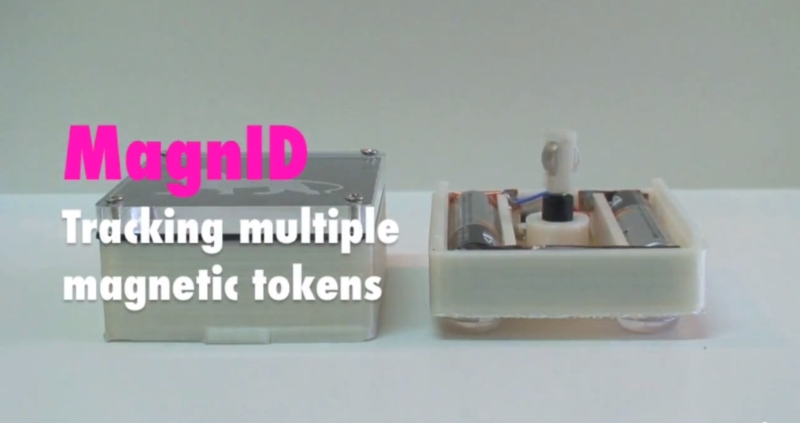New magnetic tech dubbed “MagnID” is being presented this weekend at Stanford’s annual TEI conference. It is a clever hack aimed to hijack a tablet’s compass sensor and force it to recognize multiple objects. Here is a sneak peek at the possibilities of magnetic input for tablets.
Many tablets come with some sort of triaxial magnetic sensor but as [Andrea] and [Ian]’s demo shows, they are only capable of passing along the aggregate vector of all magnetic forces. If one had multiple magnetic objects, the sensor is not able to provide much useful information.
Their solution is a mix of software and hardware. Each object is given a magnet that rotates at a different known speed. This creates complex sinusoidal magnetic fields that can be mathematically isolated with bandpass filters. This also gives them distance to each object. The team added an Arduino with a magnetometer for reasons unexplained, perhaps the ones built into tablets are not sufficient?
The demo video below shows off what is under the hood and some new input mechanics for simple games, sketching, and a logo turtle. Their hope is that this opens the door to all manner of tangible devices.
Check out their demo at Standford’s 9th annual “Tangible, Embedded, Embodied Interaction” this January 15-19, 2015.
















Seems like feeding an electromagnet from a sinusoidal voltage source would be easier (could even be as simple as adding a capacitor chosen to resonate with the electromagnet’s inductance and some inverters). Cellphone sensors are quite sensitive so it would not take much power to swamp the magnetometer at reasonable distances.
I have no idea what you could use it for but it’s a smart way to use the magnetometer in your phone for something it was never (really) meant to do. Maybe ID badges?
This reminds me of the wind-meter add-on for phones. They plug in to the headphone plug of the phone, but thats just a bit of plastic. The wind speed is actually measured by the phones magnetic sensor, and a small magnet in the rotating part of the wind meter.
I for one am thoroughly unimpressed with Standford. Seriously? This has been possible for years, but is commercially unfeasible because HELLO – batteries in your interactive objects suck + mechanical degradation of motors +.
Where are the modern MEMS motors with magnetic microglued eh?
Not seeing anything beyond a linear relationship; i.e. distance from the magnetometer.
Don’t even get me started on how such a system would be incapable of supporting a limited number of objects without serious radio hardware or computational devices.
Amazing new technology of bandpass filters in neither new nor amazing.
The heck is that? Do I hear guitar music?
Just because its Standford doesn’t mean an automatic gold star.
– Probably a Caltech Alumni
1 – It’s not from Stanford. They are just presenting it at a Stanford conference. The lady is actually from a Korean university IIRC.
2 – It wasn’t featured because it’s from Stanford (which, it’s also not).
It was featured because I thought it was an interesting hack on a magnetic sensor.
– Probably not up to date on his SoCal rivalries
You’re right. My mistake.
I’m not sure whether or not the magnetometer is the thing being hacked or cleverly used with some extra hardware peripherals though.
Based on how the magnetometer is being used. I’m fairly certain that it involves the second magnetometer in the Arduino.
Ironic someone who is slagging off a pretty decent hack can’t even spell their own handle correctly…
@Matt Freund – I enjoy reading the comments sections on your articles as much as the article itself keep it up.
That’s kind of you to say (though ambiguous, for example I enjoy the smell of brussels sprouts as much as I enjoy their foul taste :p ). I think I could probably count you as my first fan then.
Nah – I suspect a lot of people like it when the writer chips in with lots of feedback and extra explanations to silence the curious/arduino-haters/trolls. So lots of fans :) keep up the good work!
Then you can count me as a second one.
I’ve often thought about a way to dissuade people from making negative remarks, instead of trying to improve the quality of an article/the comment section.
From the articles you’ve written up, to the witty replies, I believe that you’ve found a formula which seems to work!
I really hope that you will be able to keep it up!
Turtle from ROS?
“The team added an Arduino with a magnetometer for reasons unexplained, perhaps the ones built into tablets are not sufficient?”
My first guess (emphasis on that) is that the magnetometer in the phone is optimized for low power, and provides a low update rate; probably too low to accurately see these rapidly spinning magnets.
Yep, the newer generation of magnetometers, having a sample rate of 80-160 Hz, previous gen. ran at 8Hz.
This is one of the most clever hacks I’ve ever seen. Unintended use of a common hardware, way beyond its original project.
Lame guys complaining about motors and batteries think that it is not a “hack” but a final product.
2*3*5*7 == 210
By Shannon-Martone theorem, I guess that four objects should need more than 420 Hz accelerometer sampling rate.
So to sum it up they introduce the idea of using a magnetometer to detect rotating magnets, but what to do with it they do not really know..
Maybe make a flow detector for (plastic) drainage systems for measurement? Or a viscosity metering device, make a small magnet with ‘wings’ so it’ll rotate, then drop it in a viscous liquid and measure the rotation frequency.. Might be handy in the field?